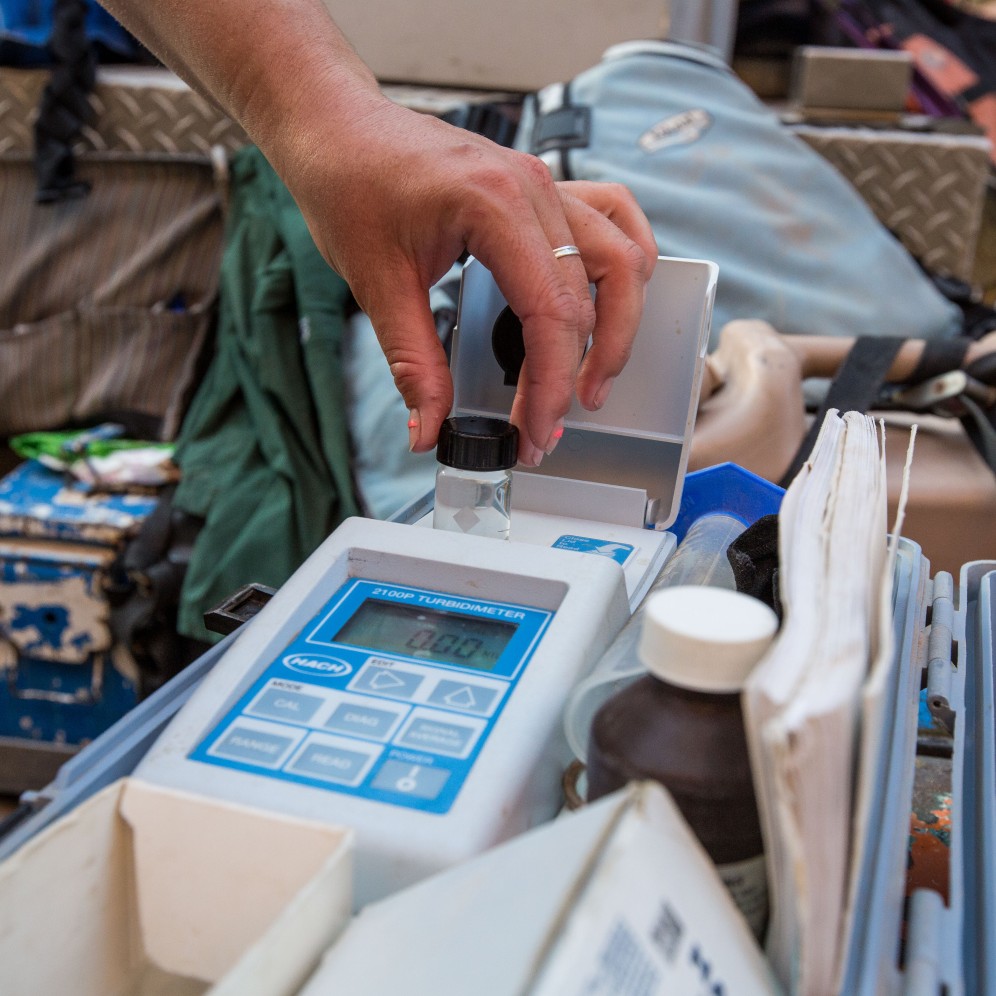Biologists Run Rapids to Monitor Fish Species in the Colorado River
When Science Merges with Adventure
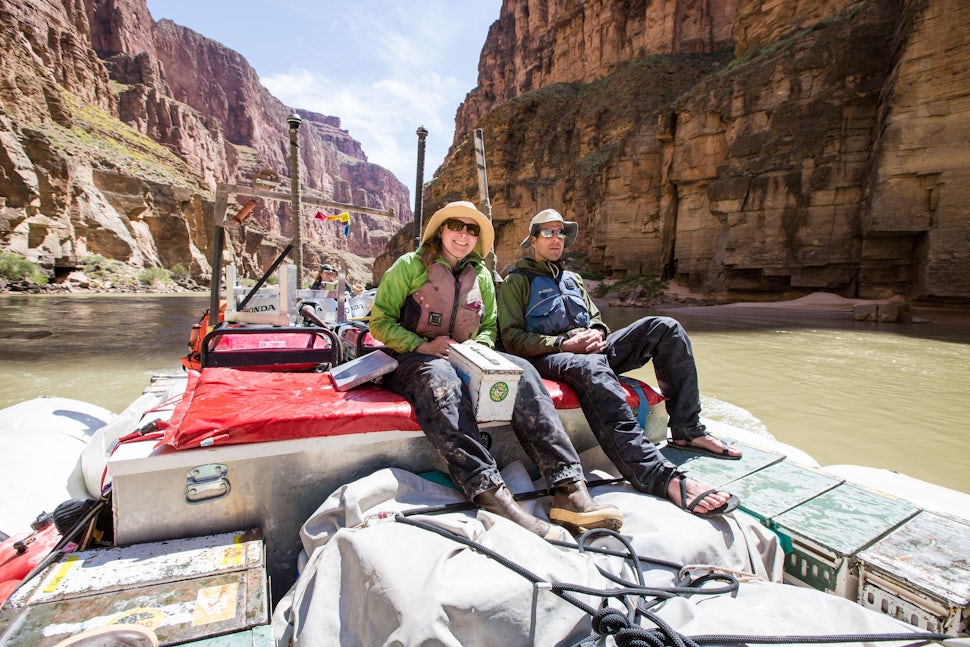
Chirping bats navigate the towering canyon walls that enclose the Colorado River from the outside world. They beat their delicate wings with certainty as they await the rise of the full moon over the rim. Their bouncing vocals, used for echolocation, and the rushing rapids of the Colorado River are the predominant sounds at the bottom of the Grand Canyon on April nights.
The day unwinds around campfires as river runners relive the day’s adventures rapid-by-rapid. Soon sleeping bags unfurl and headlamps disappear one-by-one. Boats are tightly tethered to tamarisk trunks all along the river, but just around the bend, a shadow appears on the canyon wall. A bright Q-beam spotlight—clenched in the hand of a boatman scouting the obstacles ahead—casts the shadowy outline. The profile is looking downward. Her gaze is intent, seldom looking up from the water’s surface.
 A shadow appears on the canyon wall as electrofishing commences down the Colorado River.
A shadow appears on the canyon wall as electrofishing commences down the Colorado River.
The silhouette belongs to Kristy Manuell, an Arizona Game and Fish Department (AZGFD) biologist, perched at the bow of a 16-foot aluminum sport boat outfitted for electrofishing. With 12-foot nets in hand, she and a volunteer are in position to fill the live well behind them with fish they will tag and release.
 Chad and Jan process fish that were caught at an electrofishing site.
Chad and Jan process fish that were caught at an electrofishing site.
For the team of scientists, volunteers and boatmen, ten in total, there is still work to be done under the starlit sky. They are on the second leg of a 16-day fish monitoring survey. All four boatmen and two scientists are in for the long haul—all 16 days and 281 river miles—while three new volunteers and a scientist just hiked down the Bright Angel Trail trading places with other scientists and volunteers who hiked out after the first leg, seven days and 89 miles.
AZGFD biologists, as well as the U.S. Fish and Wildlife Service, work cooperatively with the U.S. Geological Survey (USGS) to conduct a comprehensive fish monitoring survey starting below Glen Canyon Dam to Lake Mead using electrofishing, hoop netting and angling. AZGFD conducts two spring trips from Lees Ferry to Pearce Ferry and a fall trip from Diamond Creek, river mile 226, to Pearce Ferry. All of the research by the cooperating organizations falls under the Glen Canyon Dam Adaptive Management Program.
The scientists target all fish, both native and non-native species, to record gender, reproductive status, length, location, date, time and tag number. The information is entered into a database of all fish captured (more than 1 million fish), helping scientists understand fish populations in the Colorado River, which is the shade of chocolate milk this April. The growing database provides information on distribution and relative abundance of species in the main stem of the river and provides a baseline for research projects and the analysis of trends over time.
Electrofishing Under the Stars
“There’s one star,” says Jan Boyer, an AZGFD biologist.
“There’s another,” says Katie Proctor, a boatman who was contracted to guide the science expedition, as she points into the blue sky that darkens by the minute.
As soon as two stars become visible, electrofishing can begin. This method standardizes the sampling to ensure that electrofishing begins at equivalent darkness each night. The stars are also a visual cue that fish are feeding.

Adult fish venture from the depths of the river at night to feed in the shallows—a tactic that helps them avoid predation during daylight hours.
Electrofishing is a survey method that sends direct current electricity into the water, temporarily stunning fish that encounter the electrical field, allowing scientists to net them. The method works well in shallow water, and in large river systems, it works best at night when fish move into the shallows.
A stunned fish typically rises belly-up to the surface, but if the netter doesn’t respond fast enough, the fish recovers and swims off. Various species react differently. “Bluehead suckers typically roll over and sink, as do many species that do not have a swim bladder,” explains David Rogowski, the lead AZGFD biologist.
Turbidity (how muddy the water is) determines how easily and quickly fish can be spotted. Turbidity and temperature are recorded daily.
Under the stars, Katie pull-starts the generator, and Jan extends a boom from the bow and drops the anode into the water. A generator provides power to an electrofishing control box that sends a modified electrical current, designed to be less harmful to the fish, along the boom to the anode and then into the water. The aluminum hull of the boat acts as the cathode, completing the electrical circuit.
A foot pedal starts and stops the flow of electricity and serves as a safety mechanism to immediately halt the current.
 Jan and Chad net fish at an electrofishing site near camp.
Jan and Chad net fish at an electrofishing site near camp.
Earlier in the day, reflective batons marking the start and end points of up to two dozen 250-meter electrofishing sites were set throughout the entire sampling reach, which covers a few miles. Camp is situated somewhere in the middle of the reach, meaning that some sites are located upstream and some downstream.
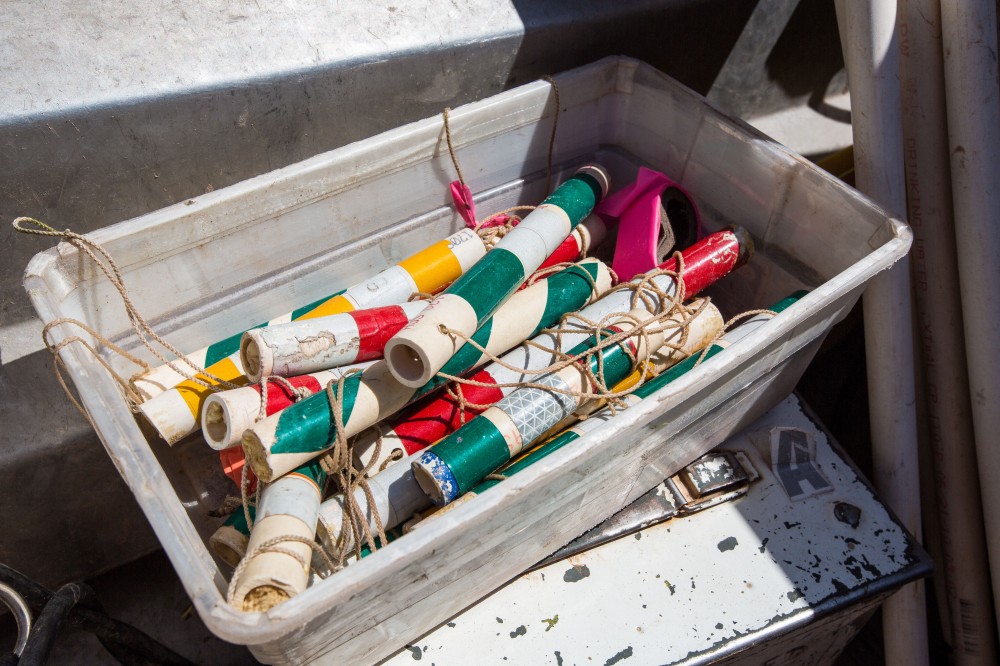 Reflective batons mark the start and end points of electrofishing sites.
Reflective batons mark the start and end points of electrofishing sites.
The Adventure in a Scientific Expedition
The Colorado River is a one-way route for commercial and private river trips traveling downstream through the Grand Canyon, but the National Park Service makes an exception to this rule for science.
Boatmen up-run rapids by the light of the moon and Q-beam spotlights to get scientists to their electrofishing sites.
The bow rears as it enters the whitewater and bounces its way through the turbulence. To pilot a sport boat upstream at dark with the added weight of scientific instrumentation demands expertise. An understanding of the river’s hydrodynamics is second nature to the science boatman who can feel the river’s movement and respond accordingly without fear or hesitation.
Dennis Harris has more than 30 years of river experience and for the past 12 years he’s been working to guide science trips. Just like the scientists he’s been working with over the years, he too can identify the five endemic fish species of the Colorado River Basin—the flannelmouth sucker, bluehead sucker, razorback sucker, humpback chub and speckled dace.
Dennis’ knowledge of natural history extends from the river into the sky. His bird calls are spot-on. When he mimics the Bell’s Vireo song, they answer back to him.
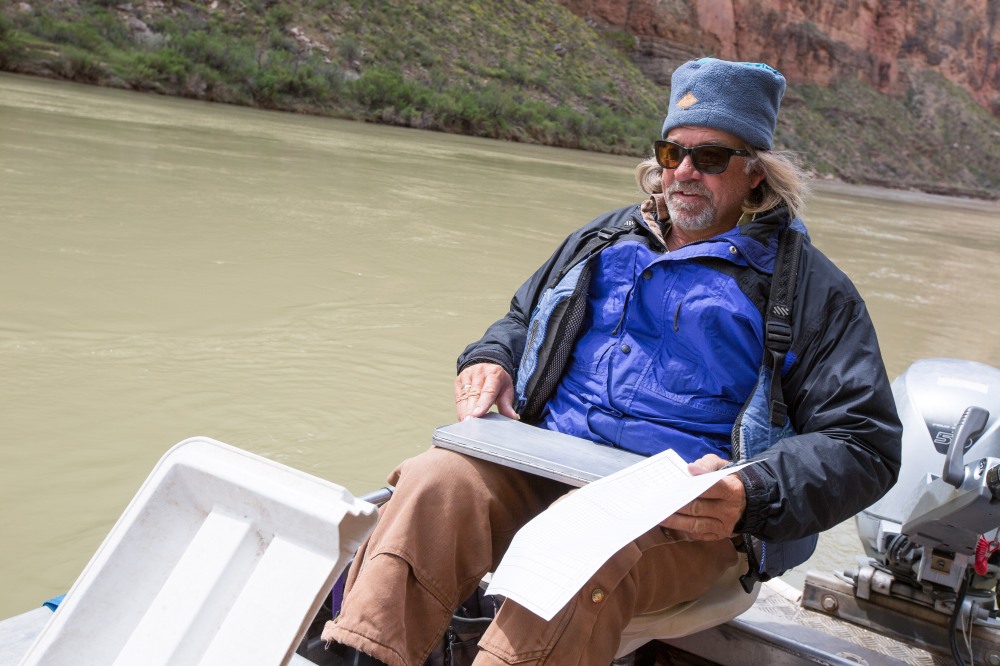 Dennis Harris
Dennis Harris
This spring, Katie Proctor guided her first science trip, operating a sport boat for the first time down the Colorado. When she looked Lava Falls straight in the eye and took off down the Class 10 rapid, her boat danced through the roaring water with elegance.
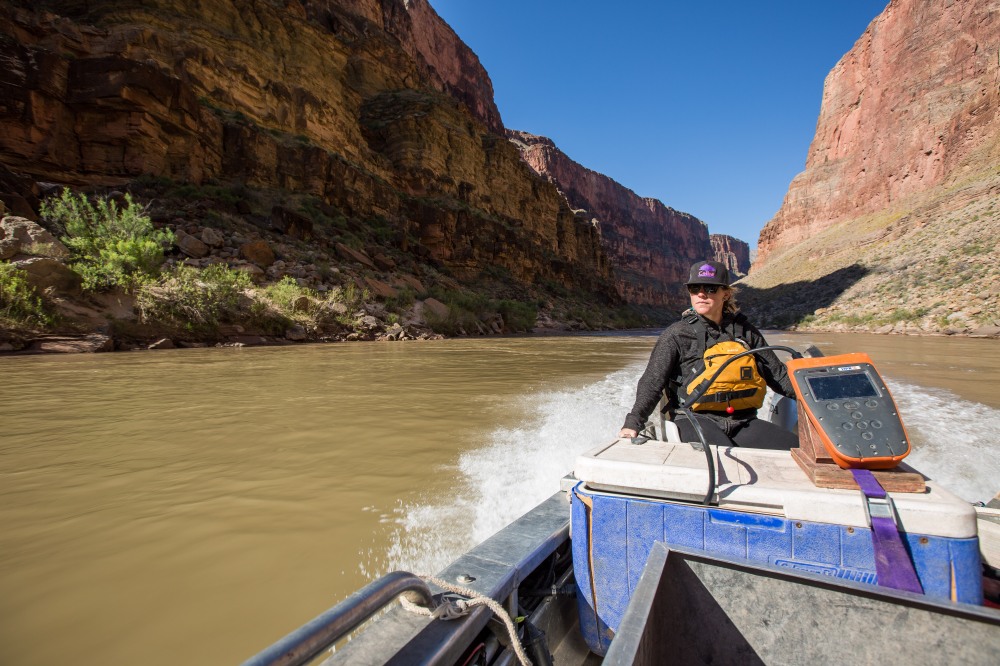 Katie Proctor
Katie Proctor
The Grand Canyon adds the element of adventure to a science expedition.
Measure, Tag, Release, Repeat
The first site, from the green start baton to the red end baton has been fished, and processing begins. Katie becomes the data recorder, as the scientist-volunteer duo begins to process fish by the light of their headlamps.
A fish is netted from the live well and placed on a wooden measuring board splashed with water to keep the specimen wet.
“Flannelmouth sucker. Sex undetermined. Not ripe,” says Jan, as she examines the fish, noting the species, gender and reproductive status.
She positions its nose to the end of the board, gently covering it’s exposed eye with her hand to keep it calm, and reads off two numbers, the total length and the nose-to-tail-fork length.
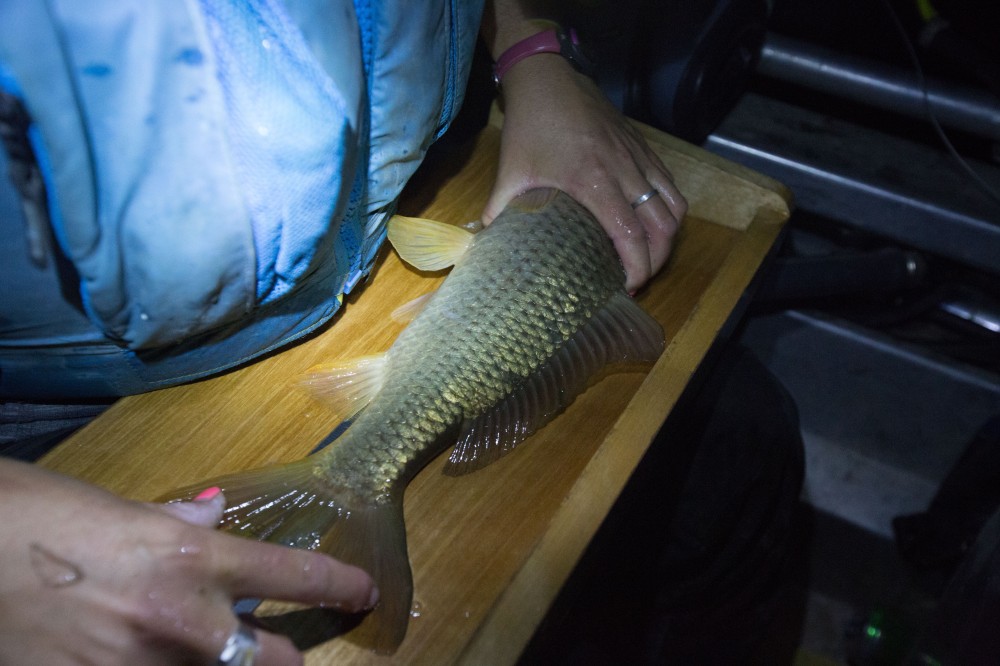 Kristy Manuell measures a non-native carp.
Kristy Manuell measures a non-native carp.
She hovers the scanner wand over the fish and there’s a beep. “We’ve got a recap,” she says.
Chad, a field biologist in Washington state who is a volunteer, reads off the unique 13-character alphanumeric string from the scanner, “Three, delta, delta, bravo, Charlie, fox, three, four, echo, alpha…”
Katie repeats the string back as she records it in the data log (3DDBCF34EA…).
In less than 30 seconds, a valuable data point has been logged. “As fish are uniquely identified via tag, we can determine things like growth (difference in length/weight between recaptures), movement, and in some cases, population and survival estimates,” explains David.
Untagged fish that are large enough to be tagged are given a passive integrated transponder (PIT) tag, which is slightly larger than a grain of rice. Tags are preloaded into a needle and injected under the skin into the body cavity on the belly near the pelvic fins.
There are a dozen fish left in the live well and processing continues before the boat is off to fish the next site.
Hoop Nets for Humpbacks
Like the adventurous river runners who ride the rapids above the surface, the humpback chub is a lover of free-flowing, fast water. With a unique hump back, this species is built to maneuver the strong current of a river that has a mind of its own. They are loyal to a habitat inside one of the seven natural wonders of the world and are not found outside the Colorado River Basin.
Shortly after it was first described in the 1940s, the humpback chub was placed on the first federal list of endangered species in 1967. Between the time it was discovered and listed as endangered, dynamite blasted through Glen Canyon for the creation of an arch-gravity dam that would rein the Colorado’s flow to fill Lake Powell, a reservoir that took 17 years to reach full pool. The dam has altered humpback chub habitat, giving non-native trout species an advantage.
In the recent past, humpback chub research and monitoring in the Grand Canyon centered on nine aggregation areas primarily using hoop nets. Over the past decade, AZGFD biologists have caught chub outside of the aggregation areas while electrofishing, a survey method that chub are less vulnerable to, so in 2016, they added hoop netting to their system-wide monitoring.
Christmas in the Canyon
Campers wake to the soft hissing of propane tanks, the sound of breakfast in the making, while the climbing sun burns away the cool shadows. After a cup of coffee, the river commute begins to retrieve the baited hoop net set the previous day. The team hopes to find empty bait bags and fish to process and release.
“It’s like opening presents on Christmas morning,” says David Rogowski, describing hoop netting as he finishes breakfast.
The two sport boats pull out of camp shortly after. As David pulls up the first hoop net, it’s heavy with fish, and he immediately spots a humpback chub among a dozen or so flannelmouth suckers.
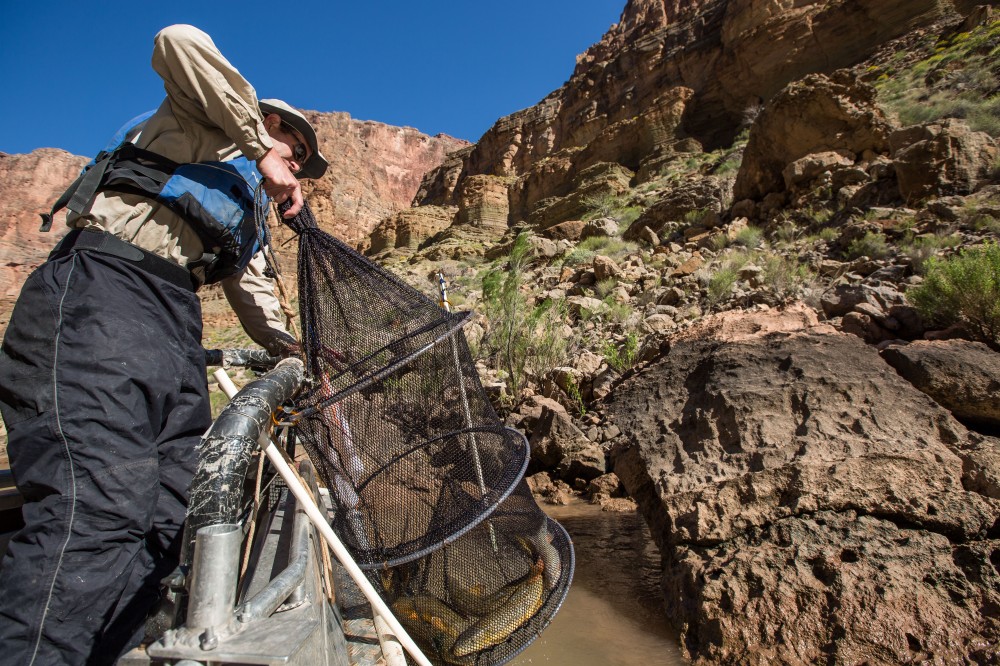 David Rogowski hauls a hoop net out of the river.
David Rogowski hauls a hoop net out of the river.
There’s always excitement when there’s a humpback chub among the catch.
 A Humpback chub
A Humpback chub
Smokies on a Hook
Two motorized rafts transport the team, science equipment and 16 days of food. Inside the meat cooler is a bag of Hillshire Farm Lit’l Smokies sausage links, but they aren’t for breakfast. These flavorful sausages are catfish bait. Electrofishing the shallows is an ineffective method for reaching bottom-feeding channel catfish that also avoid hoop nets.
On the days that scientists and volunteers have the electrofishing shift off, they angle for channel catfish.
Chip Young, a regional landowner relations specialist for the Arizona Game and Fish Department who is a trip volunteer, casts his line into the river from a driftwood log on the beach and waits for a bite.
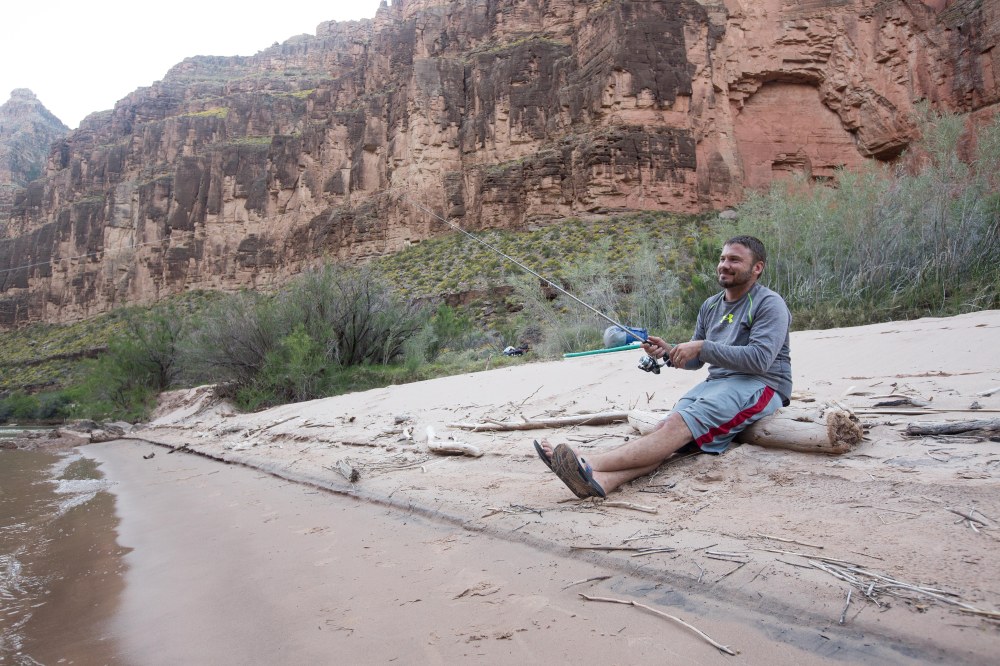 Chip Young casts a line into the river from camp.
Chip Young casts a line into the river from camp.
The catfish aren’t the only ones who eat well on the expedition. Laura Fallon, an Arizona Raft Adventures river guide and yoga instructor, and Erica Byerley, a Wilderness river guide, sailor and surfer, are chefs who elevate campfire cooking to a whole new level with steak night, Mexican night, Thai night, homemade brownies, spiced hot chocolate and banana walnut pancakes. When they aren’t spoiling the team with meals, they are piloting the 33-foot support rafts through rapids, sharing river stories, pointing out geologic formations and educating their passengers about the history and ecology of the Grand Canyon.

 Laura Fallon pilots the 33-foot support raft.
Laura Fallon pilots the 33-foot support raft.
What the Fish are Telling Scientists
Each tagged fish offers scientists a valuable piece of data that grows with each recapture. Collectively, each tagged fish and subsequent recapture data has illustrated that flannelmouth suckers continue to be the most abundant native fish in the Grand Canyon and that rainbow trout continue to outnumber natives in the colder and less turbid upper reach, closest to the dam. The inclusion of hoop nets in the monitoring has shown that Humpbackchub occur outside of their historic aggregation sites in western Grand Canyon. The recently published 2016 AZGFD Annual Report outlines the previous year’s findings. More than 4,000 fish, of 15 different species, were captured using electrofishing, along with more than 1,500 fish, of 10 different species, were captured in hoop nets. Nearly 2,200 fish were tagged and inducted into the fish database. As monitoring continues and the database grows, scientists will be able to see how species are reacting to human impacts and changing environmental conditions.
Sixteen Days on the River
Two hundred and eighty one miles later, the expedition is coming to an end. It feels like someone just opened an oven door, says Dennis as a hot breeze drifts through camp. Fingers are cracked from the dry air, bare feet sport Chaco sandal tans and hair is sun-bleached, but everyone is smiling.
For some, this trip is their first time down the Colorado River or first time rafting a river. For others, the river is like a second home during fieldwork and guiding season. For all, the river is calling their name to come back again.
We want to acknowledge and thank the past, present, and future generations of all Native Nations and Indigenous Peoples whose ancestral lands we travel, explore, and play on. Always practice Leave No Trace ethics on your adventures and follow local regulations. Please explore responsibly!
Do you love the outdoors?
Yep, us too. That's why we send you the best local adventures, stories, and expert advice, right to your inbox.


